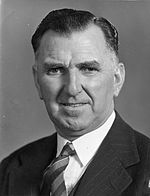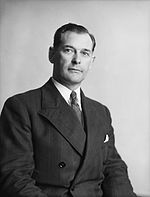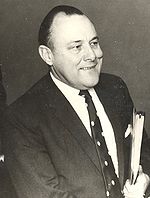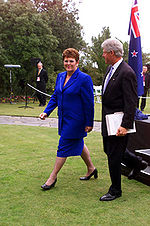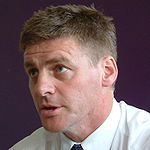- New Zealand National Party
-
New Zealand National Party
Rōpū Nāhinara
Leader John Key President Peter Goodfellow Deputy Leader Bill English Founded 13–14 May 1936 Headquarters Thorndon Quay, Wellington Youth wing Young Nationals Ideology Conservatism Political position Centre-right International affiliation International Democrat Union Official colors Blue MPs in the House of Representatives 58 / 122Website www.national.org.nz The New Zealand National Party (Māori: Rōpū Nāhinara, "National" or "the Nats") currently[update] is the largest party in the New Zealand House of Representatives and in November 2008 formed a minority government with support from three minor parties.
Contents
Policies
According to the party's website, "The National Party seeks a safe, prosperous and successful New Zealand that creates opportunities for all New Zealanders to reach their personal goals and dreams".[1]
The National Party currently[update] advocates policies of reducing taxes, reducing social welfare payments, promoting free trade, restoring or maintaining New Zealand's traditional (Western) defence and security alliances and promoting one standard of citizenship for all New Zealanders ("One law for all"). The party's policy-documents contain commitments to doubling New Zealand's economic growth, to giving welfare payments only to "those in genuine need" and to "speedy, full and final settlements to historic Waitangi Treaty claims".[citation needed]
National's 2008 tax package plan set out a three-year programme of personal tax cuts.[2]
The National Party wants to retain skilled New Zealand workers and attract overseas New Zealanders back to New Zealand. The National Party wants to better match skills of immigrants and make immigration services world class in efficiency and effectiveness, restoring confidence in their integrity.[3]
Support
Starting historically as a movement balanced between urban and rural interests, National appeals consistently to country and upper middle class voters. At the 2005 election, the Party narrowly won more votes than the New Zealand Labour Party in Auckland, New Zealand's largest city, and in the northern cities of Hamilton and Tauranga while winning almost all of the rural and provincial electoral seats. Meanwhile, the rival Labour Party won considerably more votes in the urban electorate seats of Christchurch and Dunedin.
Organisation
National features both regional and electorate-level organisational structures. National traditionally had a strongly decentralised organisation, designed to allow electorates and the five regions to appeal to the unique voter base in their area. However, in light of the 2002 election result, a review of the party organisation resulted in decisions to weaken the regional structure and to implement a more centralised structure in order to make the structure more 'appropriate' for the new mixed member proportional electoral system.[4] The Party President (currently[update] Peter Goodfellow) heads the administration outside of National's current sitting MPs.
Historically, the Party's youth wing, the Young Nationals, commonly known as the "Young Nats", has provided much political impetus as a ginger group: it gained a historical reputation as "the" social organisation in rural New Zealand and in some urban circles.[citation needed]
Two other ideology specific groups exist in National. The Bluegreens are a group within National who help formulate Environmental policy.[5] Many members of Caucus hold membership with the Bluegreens. The Blue Liberals are a National Group dedicated to promoting more liberal market and economic related policies.
History
Formation
The National Party officially formed in May 1936, but its roots go considerably further back. The party came about as the result of a merger between the United Party (known as the Liberal Party until 1927, except for a short period between 1925 and 1927 when it used the name "National Party") and the Reform Party. The United Party gained its main support from the cities, and drew upon businesses for money and upon middle class electors for votes, while the Reform Party had a rural base and received substantial support from farmers, who then formed a substantial proportion of the population.
Historically, the Liberal and Reform parties had competed against each other, but from 1931 until 1935 a coalition between the United and Reform parties held power in New Zealand. The coalition went into the 1935 election under the title of the "National Political Federation", a name adopted to indicate that the grouping intended to represent New Zealanders from all backgrounds (in contrast to the previous situation, where United served city-dwellers and Reform served farmers). However, because of the effects of the Great Depression and a perception that the existing coalition government had handled the situation poorly, the National Political Federation lost heavily in 1935 to the Labour Party, the rise of which had originally prompted the alliance.
A new party, called the New Zealand National Party, formed at a meeting held in Wellington on 13 and 14 May 1936. Erstwhile members of the United and Reform parties made up the bulk of the new party. George Forbes, Prime Minister from 1930 until 1935 and United Party Leader, opened the conference; he served as Leader of the Opposition from May until November, when the Reform MP Adam Hamilton was elected the first leader. Hamilton led the Party into its first election in 1938. He got the top job primarily due to a compromise between George Forbes (former leader of United) and Gordon Coates (former leader of Reform), neither of whom wished to serve under the other. Hamilton, however, failed to counter Labour's popular Prime Minister, Michael Joseph Savage effectively. This, along with perceptions that he remained too much under the control of Coates and that he lacked real support from his party colleagues, saw Hamilton fail to prevent Labour's re-election in 1938.
In 1940 Sidney Holland replaced Hamilton. William Polson "acted effectively as Holland's deputy" (Gustafson).
The 1943 election saw Labour's majority reduced, but it remained in power. In the 1946 elections, National also failed to unseat Labour. However, in the 1949 elections, thirteen years after the party's foundation, National finally won power, and Holland became Prime Minister.
The First National Government
Main article: First National Government of New ZealandIn 1949 National had campaigned on "the private ownership of production, distribution and exchange". Once in power the new Holland Government proved decidedly administratively conservative, retaining, for instance, the welfare state set up by the previous Labour Government; though National gained, and has largely kept (with the exception of the Muldoon government[citation needed]), a reputation for showing more favour to farmers and to business than did the Labour Party.
In 1951 the Waterfront Dispute broke out, lasting 151 days. The National government stepped into the conflict, acting in opposition to the maritime unions. Holland also used this opportunity to call the 1951 snap election. Campaigning on an anti-Communist platform and exploiting the Labour Opposition's apparent indecisiveness, National returned with an increased majority, gaining 54 parliamentary seats out of 80.
In the 1954 elections, National again won, though losing some of its seats, and Holland became Prime Minister for a third term. Towards the end of his third term, however, Holland became increasingly ill, and stepped down from the leadership shortly before the general election in 1957. Keith Holyoake, the party's long-standing deputy leader, took Holland's place. Holyoake, however, had insufficient time to establish himself in the public mind as Prime Minister, and lost in the election later that year to Labour, then led by Walter Nash.
Second National Government
Main article: Second National Government of New ZealandNash's government became very unpopular. Labour quickly acquired a reputation for poor economic management,[citation needed] and much of the public saw its 1958 Budget, known since as the "Black Budget", as miserly and puritanical. After only one term in office, Labour suffered defeat at the hands of Holyoake and the National Party in the elections of 1960.
Holyoake's government lasted twelve years, the Party gaining re-election three times (in 1963, 1966, and 1969). However, this period also saw the rise of Social Credit, which broke the National/Labour duopoly in parliament, winning former National seats from 1966. Holyoake retired from the Prime Ministership and from the Party leadership at the beginning of 1972, and his deputy, Jack Marshall, replaced him.
Marshall suffered the same fate as Holyoake. Having succeeded an experienced leader in an election-year, he failed to establish himself in time. Marshall had an added disadvantage; he had to compete against the much more popular and charismatic Norman Kirk, then leader of the Labour Party, and lost the ensuing election. Unpopular policies, including initiating clear felling of parts of the Warawara kauri forest, also needlessly alienated voters.{Adams 1980}
Third National Government
Main article: Third National Government of New ZealandWithin two years the Party removed Marshall as its parliamentary leader and replaced him with Robert Muldoon, who had previously served as Minister of Finance. An intense contest between Kirk and Muldoon followed. Kirk became ill and died in office (1974); his successor, Bill Rowling, proved no match for Muldoon, and in the 1975 elections, National under Muldoon returned comfortably to power.
The Muldoon administration, which favoured interventionist economic policies, arouses mixed opinions amongst the free-market adherents of the modern National. Bill Birch's "Think Big" initiatives, designed to invest public money in energy self-sufficiency, stand in contrast to the Party's contemporary[update] views. Muldoon's autocratic leadership style became increasingly unpopular with both the public and the Party, and together with disgruntlement over economic policy led to an attempted leadership change in 1980. Led by ministers Derek Quigley, Jim McLay, and Jim Bolger, the challenge (dubbed the "colonels' coup") against Muldoon aimed to replace him with Brian Talboys, his deputy. However, the plan collapsed as the result of Talboys' unwillingness, and Muldoon kept his position.
Under Muldoon, National won three consecutive general elections in 1975,1978 and 1981. However, public dissatisfaction grew, and Muldoon's controlling and belligerent style of leadership became less and less appealing. In both the 1978 and 1981 elections, National gained fewer votes than the Labour opposition, but could command a small majority in Parliament because of the then-used First Past the Post electoral system.
Dissent within the National Party continued to grow, however. Rebel National MPs Marilyn Waring and Mike Minogue caused particular concern to the leadership, threatening National's thin majority in parliament. When, in 1984, Marilyn Waring refused to support Muldoon's policies on visits by nuclear-powered and nuclear-armed ships, Muldoon called a snap election. Muldoon made the television announcement of this election while visibly inebriated, and some believe[citation needed] that he later regretted the decision to "go to the country". National lost the election to Labour under David Lange.
Fourth National Government
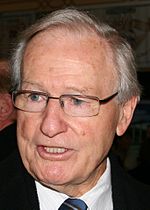 Jim Bolger, Prime Minister 1990 – 1997.
Jim Bolger, Prime Minister 1990 – 1997. Main article: Fourth National Government of New Zealand
Main article: Fourth National Government of New ZealandShortly after this loss, the Party removed Muldoon from the leadership. Jim McLay, who had replaced Brian Talboys as deputy leader shortly before the election, became the new leader. McLay, an urban liberal with right wing views on economics, however, failed to restore the party's fortunes. In 1986 Jim Bolger took over the leadership with the support of centrists within the party.
In the 1990 elections National defeated Labour in an electoral landslide and formed a new government under Jim Bolger. However, the Party lost some support from Muldoon era policy based conservatives when it continued the economic reforms which had ultimately led to the defeat of the previous Labour government — these policies, started by Labour Party Finance Minister Roger Douglas and popularly known as Rogernomics, centred on the privatization of state assets and on the removal of tariffs and subsidies. These policies alienated traditional Labour supporters, who saw them as a betrayal of the party's social service based character, but did not appear to appease the membership base of the non-parliamentary National party either, which still had a significant supporter base for the statist intervention style policies of the Muldoon Government.
Many more conservative and centrist National supporters preferred Muldoon's more authoritarian and interventionist policies over the free-market liberalism promoted by Douglas. However, the new National Party Finance Minister, Ruth Richardson, strongly supported Rogernomics, believing that Douglas had not gone far enough. (See Ruthanasia.) Her policies encouraged two National MPs to leave the National Party and form the New Zealand Liberal Party (1992). Richardson's views also met with considerable opposition within the National Party Parliamentary Caucus and for a time caused damage to the party's membership base.
Nevertheless, National was able to secure its position due partly to a strongly recovering economy. At the same time as the 1993 election, however, a referendum took place which established the MMP electoral system for future use in New Zealand general elections. This would have a significant impact on New Zealand politics. Some National Party MPs defected to a new grouping, United New Zealand in mid-1995. And as a result of the new electoral mechanics, the New Zealand First Party, led by former National MP and former Cabinet minister Winston Peters, held the balance of power after the 1996 elections. After a prolonged period of negotiation, in which New Zealand First played National and Labour off against each other (both parties negotiated complete coalition agreements), New Zealand First entered into a coalition with National.
Under the coalition agreement, Peters became Deputy Prime Minister and had the post of Treasurer especially created by the Crown for him. New Zealand First extracted a number of other concessions from National in exchange for its support. The influence of New Zealand First angered many National MPs, particularly Jenny Shipley.
When, in 1997, Shipley toppled Bolger to become National's new leader, relations between National and its coalition partner deteriorated. After Shipley sacked Peters from Cabinet in 1998, the New Zealand First party split into two groups and half the MPs followed Peters out of the coalition but the remainder broke away, establishing themselves as independents or as members of new parties of which none survived the 1999 election. From the latter group National gained enough support to continue in government with additional confidence support of Alamein Kopu a defect Alliance List MP. The visibly damaged National Government managed to survive the parliamentary term, but lost the election to Labour's Helen Clark and the Alliance's Jim Anderton, who formed a coalition government.
Opposition (1999-2008)
Shipley continued to lead the National Party until 2001, when Bill English replaced her. English, however, proved unable to gain traction against Clark, and National suffered its worst-ever electoral defeat in the 2002 elections, gaining only 27 of 120 seats. Many hoped that English would succeed in rebuilding the party, given time, but a year later polling showed the party performing only slightly better than in the election. In October 2003 English gave way as leader to Don Brash, a former governor of the Reserve Bank who had joined the National Parliamentary caucus in the 2002 election.
Under Dr Brash, the National Party's overall popularity with voters improved markedly. Mostly, however, the party achieved this by "reclaiming" support from electors who voted for other centre-right parties in 2002. National's campaigning on race relations, amid claims of preferential treatment of Māori, and amid their opposition to Labour Party policy during the foreshore-and-seabed controversy, generated considerable publicity and much controversy. Strong campaigning on a tax-cuts theme in the lead-up to the 2005 elections, together with a consolidation of centre-right support, may have contributed to the National Party's winning 48 out of 121 seats in Parliament. National, however, remained the second-largest party in Parliament (marginally behind Labour, which gained 50 seats), and had fewer options for forming a coalition government. With the formation of a new Labour-dominated Government, National remained the major Opposition party.
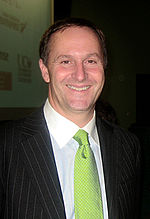 John Key, Prime Minister 2008 – present.
John Key, Prime Minister 2008 – present.
After the 2005 election defeat Don Brash's leadership of National came under scrutiny from the media, and political watchers speculated on the prospect of a leadership-challenge before the next general election due in 2008. Don Brash resigned on 23 November 2006, immediately before the release of Nicky Hager's book The Hollow Men, which contained damaging revelations obtained from private emails. John Key became the leader of the National caucus on 27 November 2006. Key fostered a more "centrist" image, discussing issues such as child poverty.
Fifth National Government
Main article: Fifth National Government of New ZealandOn 8 November 2008 the National Party, led by John Key, won 58 seats in the general election. The Labour Party, which had spent three terms in power, conceded the election and on 19 November the Governor-General swore in a new government: a centre-right coalition of the National Party, the ACT Party, led by Rodney Hide, which won 5 seats, the Maori Party, and the United Future Party.
After the election John Key entered into talks with the Maori Party even though he and his existing coalition partners commanded a majority. As of 2011[update] the National Government consists of National (58 seats), Act (5), the Maori Party (5) and United Future's Peter Dunne. As of 2011[update] the National Government has 69 seats in a 122-seat Parliament. In Key's first cabinet he gave the Act Party's Rodney Hide and Heather Roy seats outside cabinet and the Maori Party's Tariana Turia and Pita Sharples the same. Peter Dunne also received back the ministerial post outside cabinet which he had held within the immediately preceding Labour Government.
Parliamentary leaders
Order Leader Term Leader of the Opposition Prime Minister 1 Adam Hamilton 1936–1940 1936–1940 2 Sidney Holland 1940–1957 1940–1949 1949–1957 3 Keith Holyoake 1957–1972 1957–1960 1957
1960–19724 Jack Marshall 1972–1974 1972–1974 1972 5 Robert Muldoon 1974–1984 1974–1975
19841975–1984 6 Jim McLay 1984–1986 1984–1986 7 Jim Bolger 1986–1997 1986–1990 1990–1997 8 Jenny Shipley 1997–2001 1999–2001 1997–1999 9 Bill English 2001–2003 2001–2003 10 Don Brash 2003–2006 2003–2006 11 John Key 2006 – Present 2006–2008 2008 – Present Party Presidents
Name Term Sir George Wilson 1936 Colonel Claude H. Weston 1936–1940 Alex Gordon 1940–1944 Sir Wilfred Sim 1944–1951 Sir Alex McKenzie 1951–1962 John S. Meadowcroft 1962–1966 Edward Durning (Ned) Holt 1966–1973 Sir George Chapman 1973–1982 Sue Wood 1982–1986 Neville Young 1986–1989 John Collinge 1989–1994 Lindsay Tisch 1994 Geoff Thompson 1994–1998 John Slater 1998–2001 Michelle Boag 2001–2002 Judy Kirk 2002–2009 Peter Goodfellow 2009 – present Short biographies of all Presidents up to Sue Wood appear in Barry Gustafson's The First Fifty Years.
See also
- Political parties in New Zealand
- Governments of New Zealand
- National Party's Caucus and National MPs' responsibilities
References
- ^ National's Vision For New Zealand
- ^ 2008: Personal Tax
- ^ 2008: Immigration Policy Summary
- ^ Stephens, Gregory R. Electoral Reform and the Centralisation of the New Zealand National Party, MA thesis, Victoria University of Wellington
- ^ "Bluegreens". bluegreens.org.nz. 2011. http://www.bluegreens.org.nz/. Retrieved 27 August 2011.
- The First 50 Years: A History of the New Zealand National Party by Barry Gustafson (1986, Reed Methuen, Auckland) ISBN 0474001776 (includes short biographies of all National MPs from 1936 to 1986, and of a selection of organisational figures)
Adams, J.G. (1980). Kauri: A King Among Kings. Wilson & Horton Group Publication. ISBN 0-86864-080-8.
External links
Current New Zealand political parties 
Parties represented inside the
49th New Zealand ParliamentACT · Greens · Labour · Mana Party · Māori · National · JA's Progressives · United Future
Registered parties
outside of ParliamentNon-registered political parties 51st State Party · Aotearoa NZ Youth Party · Communist League · Economic Euthenics Party · Hapu Party · Human Rights · Join Australia Movement · New Munster Party · New Economics Party · Nga Iwi Morehu · Ordinary Kiwis · OurNZ · Pirate · Reform New Zealand · Restore All Things in Christ · Sovereignty
Portal:Politics - List of political parties - Politics of New Zealand International Democrat Union Asia Pacific Democrat Union · Caribbean Democrat Union · Democrat Union of Africa · European Democrat Union · European People's Party · International Women's Democrat Union · International Young Democrat Union · Union of Latin American PartiesMember parties  Democratic Party ·
Democratic Party ·  Liberal Party ·
Liberal Party ·  Austrian People's Party ·
Austrian People's Party ·  National Independence Party ·
National Independence Party ·  Union of Democratic Forces ·
Union of Democratic Forces ·  Conservative Party ·
Conservative Party ·  Independent Democrat Union ·
Independent Democrat Union ·  National Renewal ·
National Renewal ·  Kuomintang ·
Kuomintang ·  Conservative Party ·
Conservative Party ·  Democratic Union ·
Democratic Union ·  Democratic Rally ·
Democratic Rally ·  Civic Democratic Party ·
Civic Democratic Party ·  Conservative People's Party ·
Conservative People's Party ·  National Progressive Force ·
National Progressive Force ·  Social Christian Party ·
Social Christian Party ·  Nationalist Republican Alliance ·
Nationalist Republican Alliance ·  Union of Pro Patria and Res Publica ·
Union of Pro Patria and Res Publica ·  National Coalition Party ·
National Coalition Party ·  Union for a Popular Movement ·
Union for a Popular Movement ·  United National Movement ·
United National Movement ·  Christian Democratic Union ·
Christian Democratic Union ·  Christian Social Union of Bavaria ·
Christian Social Union of Bavaria ·  New Patriotic Party ·
New Patriotic Party ·  New Democracy ·
New Democracy ·  Unionist Party ·
Unionist Party ·  National Party ·
National Party ·  Fidesz ·
Fidesz ·  Independence Party ·
Independence Party ·  Jamaica Labour Party ·
Jamaica Labour Party ·  Grand National Party ·
Grand National Party ·  National Party ·
National Party ·  Conservative Party ·
Conservative Party ·  Conservative Party ·
Conservative Party ·  Christian People's Party ·
Christian People's Party ·  Democratic and Social Centre – People's Party ·
Democratic and Social Centre – People's Party ·  Democratic Party of Serbia ·
Democratic Party of Serbia ·  Slovenian Democratic Party ·
Slovenian Democratic Party ·  People's Party ·
People's Party ·  United National Party ·
United National Party ·  Moderate Party ·
Moderate Party ·  Conservative Party ·
Conservative Party ·  Republican PartyCategories:
Republican PartyCategories:- New Zealand National Party
- Political parties in New Zealand
- Liberal-conservative parties
- International Democrat Union member parties
Wikimedia Foundation. 2010.

